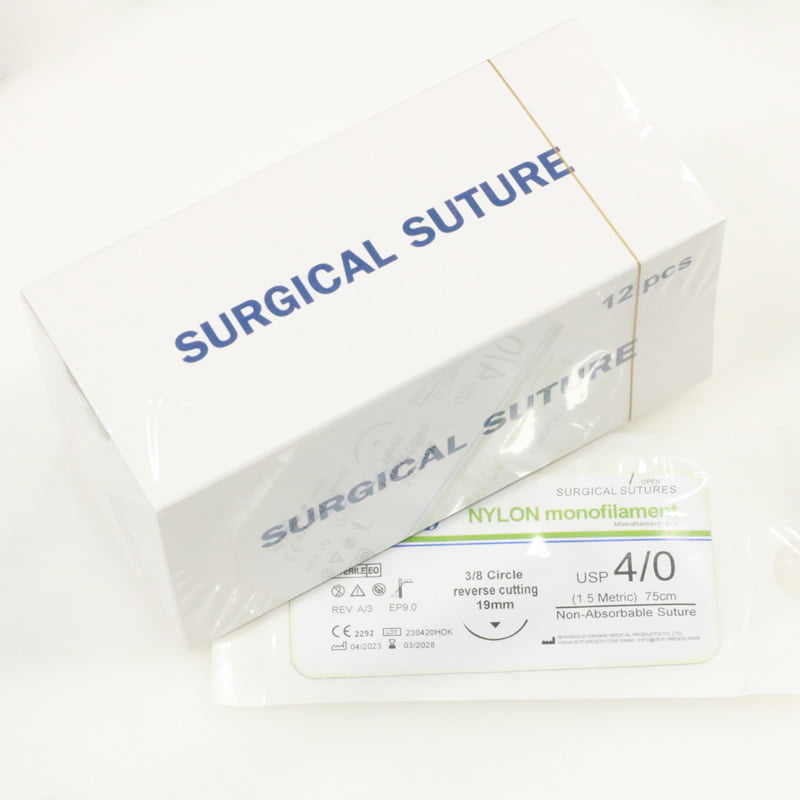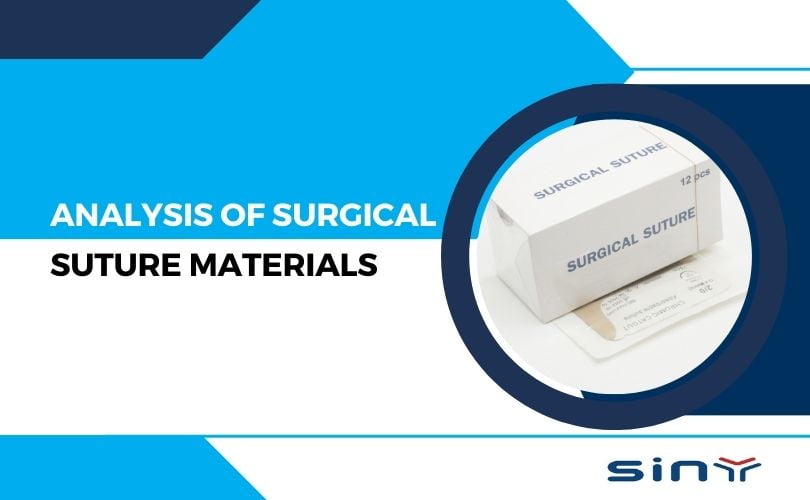Surgical sutures, which are also called sutures, are among the most preferred medical devices among other medical materials used for closing and sewing wounds (wound closure elements). Surgical sutures have evolved significantly with a 4000-year history of discovery and use. Numerous varieties of surgical sutures have been developed in conjunction with contemporary medicine. Natural, synthetic, absorbable, non-absorbable, antibacterial, multifilament, and monofilament surgical sutures are all available.
Silk is a time-honored choice, known for its smooth texture and ease of handling. However, its biodegradability and potential for allergic reactions have led to the development of synthetic sutures. Brands such as Siny have introduced high-quality, sterile synthetic sutures that promise superior biocompatibility and reduced risk of infection.
Table of Contents
What Is a Surgical Suture?
A surgical suture is equipment used to hold bodily tissues together and round the edges of cracks following surgery or damage. A needle with a length of thread attached is used to apply sutures, and there are numerous varieties with different needle forms, sizes, and thread compositions.
- Dissolvable stitches, another name for absorbable sutures, are stitches the body can naturally absorb and dissolve while a wound heals.
- Absorbable sutures are stitches made from materials the body can naturally absorb over time.
Why are sutures used?
Deep cuts or wounds are closed with stitches. A surgeon might have to stitch the two margins of a deep wound together layer by layer. When this occurs, the incision is eventually closed by sutures left beneath the skin’s surface.

- Tissue Support: Sutures provide structural support to tissues during the healing period. This support minimizes tension on the wound, reducing the risk of complications such as dehiscence (wound reopening) and promoting proper healing.
- Infection Prevention: Closed wounds are less susceptible to infection. Sutures create a barrier that protects the wound from external contaminants, minimizing the chances of microbial invasion and subsequent infections.
- Enhancing Cosmetic Outcomes: Sutures are crucial in achieving aesthetically pleasing results after surgeries. Carefully aligning and securing tissue minimizes scarring and ensures a more cosmetically appealing outcome.
- Internal Tissue Repair: Sutures are used for repairing and rejoining tissues in specific surgical procedures, especially those involving internal organs. This internal suturing is vital for restoring the normal function of organs and structures.
Types of surgical suture materials
Surgical sutures are medical devices that hold tissues together after surgery or injury. They come in various materials, each offering unique properties and benefits. The two main types of sutures are silk and synthetic.
Surgeons have utilized silk sutures, crafted from natural fibers derived from the silkworm. These sutures, recognized for their smooth texture and ease of handling, possess the quality of being absorbable.
This indicates that over time, the sutures break down and the body naturally absorbs them. This characteristic proves particularly advantageous in procedures where extended, long-term support is not deemed necessary.

Suture Material
- Silk: Typically braided and naturally made, silk sutures
- Nylon: Nylon creates a type of natural monofilament suture
- Polypropylene: This material creates a monofilament suture.
- Polyester: This form is synthetic and braided
- Cotton: Cotton thread serves as an excellent suture material; specifically, it is highly effective when employed in clean wounds
Sutures can be classified by material structure.
- Braided: Several threads are braided together for this type of suture. Though there may be an increased risk of infection, these braided sutures offer better security.
- Monofilament: A single thread makes up the suture material, making it pass through tissue more easily.
Finally, materials for sutures can be natural or manufactured. Since every suture material is sterile, this differentiation is less useful.
Absorbable vs. Non-Absorbable Sutures
Sutures play a pivotal role in wound closure and tissue repair, and understanding the differences between absorbable and non-absorbable sutures is crucial for medical professionals. Here’s a comprehensive comparison:
Absorbable Sutures
Surgeons typically choose absorbable sutures to oppose and ligate tissue that will be inaccessible after implantation. Absorbable suture materials are preferred due to their ability to degrade over time, eliminating the need for removal after healing has occurred.

Bodily fluids hydrolyze these sutures. During absorption, suture wound support reduces, and then the suture begins to be absorbed. Suture material loses mass/volume as time progresses.
- Material: Absorbable sutures are typically made from materials that break down over time within the body.
- Natural vs. Synthetic: They can be derived from natural sources like catgut (animal intestines) or synthesized from materials like polyglactin or polyglycolic acid.
- Degradation: These sutures are designed to degrade naturally over a specific period, eliminating the need for removal in most cases.
- Applications are ideal for internal stitches and tissues with minimal tension, as they gradually lose strength and disappear.
- Advantages: Reduce the risk of infection associated with suture removal. Suitable for surgeries where prolonged wound support is unnecessary.
Non-Absorbable Sutures
- Material: Non-absorbable sutures are made from materials that do not break down within the body.
- Materials Used: Common materials include silk, nylon, polyester, and stainless steel.
- Durability: These sutures maintain their tensile strength over time and require manual removal after the wound has sufficiently healed.
- Applications: Ideal for external stitches, areas with high tension, and situations where prolonged support is necessary.
- Advantages: Provide long-term wound support, especially in cases where tissue healing is slow, or tension on the wound is a concern.
Absorbable and non-absorbable sutures depend on factors such as the type of surgery, the location of the wound, and the expected duration of suture support. Healthcare professionals carefully consider these factors to ensure optimal outcomes in patient care.
Advantages and Disadvantages of Silk Sutures
Surgeons have utilized silk sutures in surgical procedures for centuries, drawn to their inherent properties. Silk sutures‘ critical advantage is their smooth texture, which allows for easy handling during suturing. This makes silk sutures ideal for delicate procedures where precision is paramount. Additionally, silk sutures have high tensile strength, providing excellent support for the wound during healing.
Silk sutures also have their drawbacks. One significant disadvantage is their biodegradability. The body eventually absorbs silk sutures, which can be beneficial and problematic. While the absorption eliminates the need for suture removal, it also means that the sutures may not provide long-term support for the wound. Another potential concern with silk sutures is their potential for allergic reactions in some individuals. This can lead to complications and delays in wound healing.
Cost-effectiveness and availability of silk and synthetic sutures
Silk sutures, rooted in tradition, offer a cost-effective choice with widespread availability. Meanwhile, synthetic sutures, such as Polyglactin and Polyglycolic acid, provide a modern, cost-efficient alternative. Balancing between the established and the innovative, healthcare professionals consider both options for optimal outcomes, ensuring accessibility and quality in various medical settings.

Silk Sutures: Affordable Tradition
Silk Surgical Suture, rooted in traditional practice, offer a cost-effective solution. The natural material is widely available and balances affordability with reliable performance. Its long-standing presence in the market ensures accessibility, making silk sutures a practical choice for various medical settings.
Synthetic Sutures: Cost-Efficient Innovation
Synthetic sutures, derived from advanced materials like polyglactin and polyglycolic acid, blend innovation with cost-effectiveness. Their streamlined manufacturing process results in affordability without compromising quality. Synthetic sutures contribute to healthcare efficiency by providing accessible options in modern surgical practices.
Considered Choices for Optimal Outcomes
Healthcare professionals navigate the cost-effectiveness and availability of silk and synthetic sutures to make considered choices. This strategic approach ensures that the chosen suture type aligns with surgical needs, patient requirements, and budget considerations, ultimately leading to optimal outcomes in diverse medical scenarios.
Final Summary
In the realm of siny medical surgical sutures, both silk and synthetic materials have their own set of advantages and disadvantages. With their smooth texture and high tensile strength, silk sutures remain a viable option for many procedures. However, synthetic sutures have emerged as a superior alternative, offering improved biocompatibility, customization options, and a reduced risk of infection.
When choosing a suitable suture material, it’s essential to consider the specific requirements of each surgical procedure. Factors such as strength, elasticity, biocompatibility, tissue reaction, cost-effectiveness, and availability should be carefully evaluated. Healthcare professionals and patients can make informed decisions that optimize wound healing outcomes by understanding the characteristics of silk and synthetic sutures.
FAQs: Surgical Sutures
What is the length of time for sutures?
The length of time sutures remain in place varies depending on factors such as the type of surgery and the location of the wound. Typically, sutures are left in for a period ranging from a few days to a few weeks. Surgeons determine the specific duration based on the expected healing time for the particular type of tissue involved.
When should sutures be placed?
Sutures should be placed immediately after a wound occurs or a surgical incision is made. The timely placement of sutures is crucial to facilitate wound closure, minimize the risk of infection, and promote optimal healing. The decision on when to place sutures depends on the nature and severity of the injury or surgery.
What material are surgical sutures made of?
Surgical sutures can be made from various materials, including both natural and synthetic options. Natural materials may include silk or catgut derived from animal sources. Synthetic materials encompass a range of polymers, such as polyglactin, polyglycolic acid, nylon, and polypropylene. The choice of material depends on factors like the type of surgery, tissue characteristics, and desired absorption properties.
What type of sutures are absorbable?
Absorbable sutures are designed to break down and be absorbed by the body over time. Materials commonly used for absorbable sutures include catgut, polyglactin, polyglycolic acid, and poliglecaprone. These sutures are particularly suitable for internal stitches and situations where the suture is not manually removed, contributing to a more convenient and efficient healing process.



























































